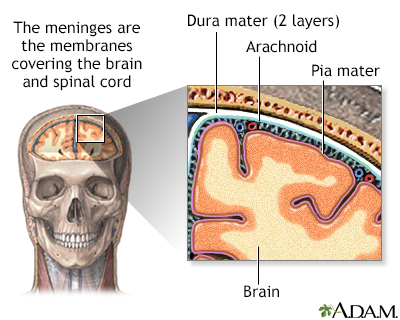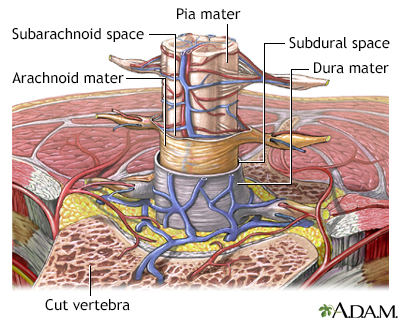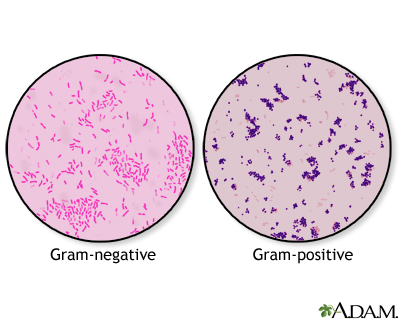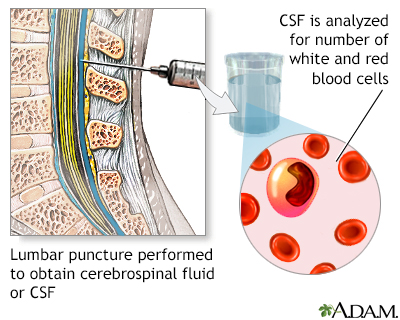Gram-negative meningitis
Meningitis is present when the membranes covering the brain and spinal cord become swollen and inflamed. This covering is called the meninges.
Meningitis
Meningitis is an infection of the membranes covering the brain and spinal cord. This covering is called the meninges.

Bacteria are one type of germ that may cause meningitis. Gram-negative bacteria are a type of bacteria that behave in a similar manner in the body. They are called gram-negative because they turn pink when tested in the laboratory with a special stain called Gram stain.
Causes
Acute bacterial meningitis can be caused by different Gram-negative bacteria including meningococcus and H influenzae.
Meningococcus
Meningitis is an infection of the membranes covering the brain and spinal cord. This covering is called the meninges. Bacteria are one type of germ ...

H influenzae
Meningitis is an infection of the membranes covering the brain and spinal cord. This covering is called the meninges. Bacteria are one type of germ ...

This article covers Gram-negative meningitis caused by the following bacteria:
- Escherichia coli
- Klebsiella pneumoniae
- Pseudomonas aeruginosa
- Serratia marcescens
Gram-negative meningitis is more common in infants than adults. But it can also occur in adults, especially those with one or more risk factors. Risk factors in adults and children include:
- Infection (especially in the abdomen or urinary tract)
- Recent brain surgery
- Recent injury to the head
- Spinal abnormalities
-
Spinal fluid shunt placement after brain surgery
Shunt
Ventriculoperitoneal shunting is surgery to treat excess cerebrospinal fluid (CSF) in the cavities (ventricles) of the brain (hydrocephalus)....
 ImageRead Article Now Book Mark Article
ImageRead Article Now Book Mark Article - Urinary tract abnormalities
- Urinary tract infection
Urinary tract infection
A urinary tract infection, or UTI, is an infection of the urinary tract. The infection can occur at different points in the urinary tract, including...
 ImageRead Article Now Book Mark Article
ImageRead Article Now Book Mark Article - Weakened immune system
Symptoms
Symptoms usually come on quickly, and may include:
- Fever and chills
- Mental status changes
Mental status changes
Confusion is the inability to think as clearly or quickly as you normally do. You may feel disoriented and have difficulty paying attention, remembe...
 ImageRead Article Now Book Mark Article
ImageRead Article Now Book Mark Article - Nausea and vomiting
- Sensitivity to light (photophobia)
- Severe headache
- Stiff neck (meningismus)
- Symptoms of a bladder, kidney, intestine, or lung infection
Other symptoms that can occur with this disease:
- Agitation
- Bulging fontanelles in infants
Bulging fontanelles
A bulging fontanelle is an outward curving of an infant's soft spot (fontanelle).
 ImageRead Article Now Book Mark Article
ImageRead Article Now Book Mark Article - Decreased consciousness
- Poor feeding or irritability in children
- Rapid breathing
- Unusual posture, with the head and neck arched backwards (opisthotonos)
Opisthotonos
Opisthotonos is a condition in which a person holds their body in an abnormal position. The person is usually rigid and arches their back, with thei...
Read Article Now Book Mark Article
Exams and Tests
The health care provider will perform a physical exam. Questions will focus on symptoms and possible exposure to someone who might have the same symptoms, such as a stiff neck and fever.
If the provider thinks meningitis is possible, a lumbar puncture (spinal tap) will likely be done to remove a sample of spinal fluid for testing.
Spinal tap
Cerebrospinal fluid (CSF) collection is a test to look at the fluid that surrounds the brain and spinal cord. CSF acts as a cushion, protecting the b...

Other tests that may be done include:
- Blood culture
Blood culture
A blood culture is a laboratory test to check for bacteria or other germs in a blood sample.
 ImageRead Article Now Book Mark Article
ImageRead Article Now Book Mark Article - Chest x-ray
Chest x-ray
A chest x-ray is an x-ray of the chest, lungs, heart, large arteries, ribs, and diaphragm.
 ImageRead Article Now Book Mark Article
ImageRead Article Now Book Mark Article - CT scan of the head
CT scan of the head
A head computed tomography (CT) scan uses many x-rays to create pictures of the head, including the skull, brain, eye sockets, and sinuses.
 ImageRead Article Now Book Mark Article
ImageRead Article Now Book Mark Article - Gram stain or, other special stains, and culture of the spinal fluid
Treatment
Antibiotics will be started as soon as possible. Ceftriaxone, ceftazidime, and cefepime are the most commonly used antibiotics for this type of meningitis. Other antibiotics may be given, depending on the type of bacteria.
If you have a spinal shunt, it may be removed.
Outlook (Prognosis)
The earlier treatment is started, the better the outcome.
Many people recover completely. But, many people have permanent brain damage or die of this type of meningitis. Young children and adults over age 50 have the higher risk for death. How well you do depends on:
- Your age
- How soon treatment is started
- Your overall health
Possible Complications
Long-term complications may include:
- Brain damage
- Buildup of fluid between the skull and brain (subdural effusion)
Subdural effusion
A subdural effusion is a collection of cerebrospinal fluid (CSF) trapped between the surface of the brain and the outer lining of the brain (the dura...
Read Article Now Book Mark Article - Buildup of fluid inside the skull that leads to brain swelling (hydrocephalus)
Hydrocephalus
Hydrocephalus is a buildup of fluid inside the skull that leads to the brain pushing against the skull. Hydrocephalus means "water on the brain. "...
 ImageRead Article Now Book Mark Article
ImageRead Article Now Book Mark Article - Hearing loss
- Seizures
Seizures
A seizure is the physical changes in behavior that occurs during an episode of specific types of abnormal electrical activity in the brain. The term ...
 ImageRead Article Now Book Mark Article
ImageRead Article Now Book Mark Article
When to Contact a Medical Professional
Call 911 or the local emergency number or go to an emergency room if you suspect meningitis in a young child who has the following symptoms:
- Feeding problems
- High-pitched cry
- Irritability
- Persistent unexplained fever
Meningitis can quickly become a life-threatening illness.
Prevention
Prompt treatment of related infections may reduce the severity and complications of meningitis.
Reviewed By
Jatin M. Vyas, MD, PhD, Associate Professor in Medicine, Harvard Medical School; Associate in Medicine, Division of Infectious Disease, Department of Medicine, Massachusetts General Hospital, Boston, MA. Also reviewed by David C. Dugdale, MD, Medical Director, Brenda Conaway, Editorial Director, and the A.D.A.M. Editorial team.
Centers for Disease Control and Prevention website. Bacterial meningitis. www.cdc.gov/meningitis/bacterial.html. Reviewed July 15, 2021. Accessed November 10, 2022.
Nath A. Meningitis: bacterial, viral, and other. In: Goldman L, Schafer AI, eds. Goldman-Cecil Medicine. 26th ed. Philadelphia, PA: Elsevier; 2020:chap 384.
Hasbun R, Van de Beek D, Brouwer MC, Tunkel AR. Acute meningitis. In: Bennett JE, Dolin R, Blaser MJ, eds. Mandell, Douglas, and Bennett's Principles and Practice of Infectious Diseases. 9th ed. Philadelphia, PA: Elsevier; 2020:chap 87.






 All rights reserved.
All rights reserved.